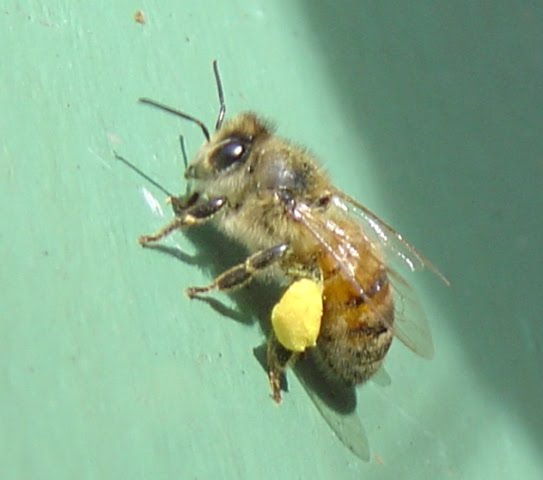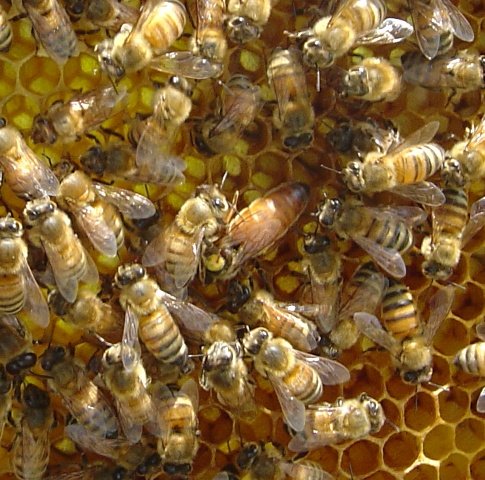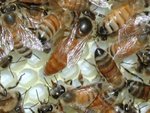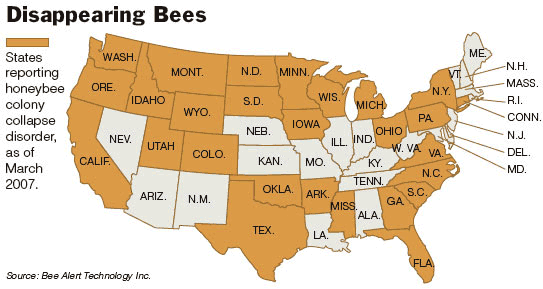Well it is the end of October. We have been preparing our hives for winter since the honey crop was removed on September first. I have come to learn that next years beekeeping begins now in the fall. In order to have strong hives next spring the colonies need to be properly prepared in the fall. I will say it again… The success of next years beekeeping depends on what we do now.
.
.
.
.
.
.
.
.
Above: A hive top feed being installed on a colony. You can see that a pollen substitute patty, and a Crisco and sugar patty has been installed in the hive. The pollen patty ensures nutrition. The Crisco and sugar patty treats varroa and trachea mites.
Some people are beehavers. They have bees, there bees die, they get more bees, they have them, those bees die.
Some people are beekeepers. They keep there bees healthy year after year..
.
.
.
.
.
.
.
Above: 2:1 sugar syrup being poured into the hive top feeder. The bees will collect this sugar syrup and store it for food to be consumed this winter.
I have been amazed that our mite problem still exists in the previously treated hives. Once high levels of varroa mite levels are detected, treatment of the hives began immediately. It takes 3 weeks to treat with formic acid pads, and with the weather getting cooler the formic acid vapors will not be as effective as they were in early September.
.
.
.
.
.
.
.
.
Above: Robbing was so bad this year that I had to install weather stripping between the feeders and the cover to prevent bees from stealing the sugar syrup.
Our winter preparations in October and the first two weeks of November include the following.
1: Colonies are inspected for health. Is the colony strong? Is the colony health? Is there an adequate number of bees to insure the colonies survival through the winter months. Have the bees produced enough comb to store food. Sometimes the combs of bees need to be rearranged so that all the drawn comb and honey stores are located in the upper brood chamber. Empty frames and un-drawn frames of foundation are moved to the lower brood chamber. Since the bees will over-winter in the top box, this should be the location of most of their stores.
2: The hives are inspected for adequate winter stores of pollen and honey. If there is less than 50 lbs of honey in the colony the hives will be fed with a 2:1 ration of sugar syrup. Two parts sugar to one part water. All our colonies are fed sugar syrup and pollen substitute to insure they have more than enough supplies for winter.
Robbing has been a big problem this year. One drop of syrup outside the hive causes thousands of bees to go searching for the syrup. Once this starts hives will attempt to rob other hives of their winter stores. The battle is amazing to watch, but it is not good for the bees. Because of this problem we have installed entrance reducers on all the hives to help them protected themselves against robbing.
3: Mouse guards and entrance reducers are installed on all the hives to keep mice from building nests in the dry cozy hives..
.
.
.
.
.
.
.
Above: Formic acid pads installed over a colony in order to reduce the varroa mites.
4: All colonies are evaluated for varroa mites. If varroa mites are found in large numbers the colonies are treated for varroa and trachea mites using formic acid applications.
5: Ventilation will be provided above the colonies to allow moisture out of the hive. By placing two square toothpicks under the back side of the inner cover, a ventilation space is created. This ventilation will keep moisture from building up on the underside of the cover which would drip on the colony. The cold will not harm a healthy cluster of bees, but cold damp conditions will. I also install a layer of newspaper above the ventilation space. This newspaper will absorb any moisture that may collect, keeping it from effecting the colony..
.
.
.
.
.
.
.
.
Above: Entrance reducers and mouse guards are installed on the hives to prevent the entrance of mice. The mice love to spend the winter in the dry hives. Once inside the mice will destroy the comb to make room for it's nest. You can see the bees bringing in the fall pollen.
6: Review this past seasons beekeeping notes. Identify what went wrong and why. Correct these deficiencies.
Learn by your mistakes!
October 30, 2007
Winterize
Labels:
Beekeeping,
Feeding,
Pollen Patties,
Sugar Syrup,
Varroa Mite
October 3, 2007
The Great Extraction
On September 1st we removed and extracted the honey from our hives here on the Cape. As suspected and commented on in previous posts it was a very lean year honey wise.
With the potential to produce 350 pounds of honey our hives produced only 28 pounds. Some beekeepers in our area did not get any honey from there hives this year. The combination of a very cold spring, and a very dry summer created no abundance of nectar. What little the bees collected was used to keep the hive running.
With the potential to produce 350 pounds of honey our hives produced only 28 pounds. Some beekeepers in our area did not get any honey from there hives this year. The combination of a very cold spring, and a very dry summer created no abundance of nectar. What little the bees collected was used to keep the hive running.
Right: A frame of capped honey
.
.
.
.
.
.
.
.
.
.
.
.
.
The process of extracting honey consists of first removing the honey supers from the hives. To achieve this, bee escape boards are placed between the honey supers (boxes) and the brood chamber (where the bees raise their young). Over a few days the bees leave the honey super and are unable to return to it through the escape board. The honey boxes can then be removed.
.
Left: Uncapping the honey comb with a hot electric knife
.
.
.
.
.
.
.
.
.
.
.
.
.
.
.
.
.
.
Honey is produced by the collection of nectar from the local flowers. The nectar contains about 1% sugar. The bees collect the nectar and store it in the cells of the comb. The water is evaporated from the nectar leaving only the sugar behind. Once the honey is “ripe” (completed) the bees cap over the cells with a white wax. The wax capping seals the cells and keeps the honey from absorbing moisture from the air. The honey is now sealed in a air tight container of wax. Normally the bees would save the honey and use it as food during the winter months. The cell would be uncapped when the honey was needed as food. Fortunately for the beekeeper bees are hoarders of honey. They will produce much more honey than they need to survive the winter.
The Beekeeper can take for himself what the bees will not need. Yum.
The extraction process starts with the removal of the white wax cappings. A hot electric knife is used to cut the wax cappings off the comb exposing the liquid honey in the cells. Frames of honey which are not capped are not extracted. Uncapped honey may contain excess water which will in time cause the honey to ferment. Only ripe capped honey comb is extracted.
Once the frame of honey is uncapped it is placed in a centrifuge (extractor). The comb is spun in the extractor and centrifugal force causes the liquid honey out of the comb and into the extractor. The empty combs are then removed and stored to be used again next season.
.
.
Right: Our two fram hand crank extractor
.
.
.
.
.
.
.
.
.
.
.
.
.
.
.
The best part of extracting is the sent of hot honey produced by the electric uncapping knife. The smell is indescribably sweet.
Once the honey gate is open liquid honey pours out into a series of screens designed to remove any wax which may be in the honey. The honey drips through the screens into a honey bucket. Each bucket holds about 60 pounds of honey.
The honey is stored for 24 hours which allows any small particles of wax to float to the top of the honey bucket. The honey is then poured from the bottom of the pail through a honey gate and into the bottles.
Each years honey is different from the previous years, depending on what flowers the honey was collected from. As you can see, this years honey was very dark, compared to last years honey which was very golden.
Once the honey gate is open liquid honey pours out into a series of screens designed to remove any wax which may be in the honey. The honey drips through the screens into a honey bucket. Each bucket holds about 60 pounds of honey.
The honey is stored for 24 hours which allows any small particles of wax to float to the top of the honey bucket. The honey is then poured from the bottom of the pail through a honey gate and into the bottles.
Each years honey is different from the previous years, depending on what flowers the honey was collected from. As you can see, this years honey was very dark, compared to last years honey which was very golden.
.
Left: Extracted liquid honey pouring into the filter screens
.
.
.
.
.
.
.
.
.
.
.
.
Once the honey is removed from the hive, preparations begin for the over wintering of the hives.
But more about that next time.
Subscribe to:
Posts (Atom)
Spring

Peach Pollen
Spring Pollen

Queen Cell

Well Fed Queen Cell
Marked Queen

Queen produced from my second graft attempt












